key RENAULT KANGOO ZERO EMISSION 2012 X61 / 2.G User Guide
[x] Cancel search | Manufacturer: RENAULT, Model Year: 2012, Model line: KANGOO ZERO EMISSION, Model: RENAULT KANGOO ZERO EMISSION 2012 X61 / 2.GPages: 213, PDF Size: 6.08 MB
Page 70 of 213

JauneNoirNoir texte
1.65
ENG_UD25289_3
Afficheurs et indicateurs (X61 électrique - Renault)
ENG_NU_911-4_F61e_Renault_1
DiSPlAYS AND iNDicA tOrS (3/3)
Display selection keys 5 or 6
Depending on the vehicle, pressing the
button repeatedly enables the informa-
tion on the display to be selected and
the trip mileage recorder to be reset (for
this, the trip mileage must be selected
on the display). –
Display selection
Press briefly to move from the total
mileage to the trip mileage and vice
versa.
– resetting the trip mileage recorder
Once trip mileage has been selected on
the display, press and hold the button.
multifunction display
t otal mileage recorder.
t rip mileage recorder.
Setting the time.
Or
t rip computer and warning system
Refer to the information on the “Trip
computer” in Section 1.
the presence and operation of the display and indicators DePeNDS ON the level OF eQUiPmeNt AND the cOUNtr Y.
5
6
Page 71 of 213

control instruments ............................... (up to the end of the DU)
instrument panel messages ..................(up to the end of the DU)
instrument panel ................................... (up to the end of the DU)
warning lights ........................................ (up to the end of the DU)
1.66
ENG_UD23006_2
Ordinateur de bord : généralités (X61 électrique - Renault)\
ENG_NU_911-4_F61e_Renault_1
Jaune NoirNoir texte
Trip computer
triP cOmPUter: general information (1/2)
t rip computer and warning
system A
Depending on the vehicle, this includes
the following functions:
– distance travelled;
– journey parameters;
– information messages;
– operating fault messages (associ -
ated with the
© warning light);
– warning messages (connected to the
® warning light).
All these functions are described on the
following pages. a)
Total mileage and trip mileage re -
corder;
b) journey parameters:
– Total energy consumption since
the last reset;
– average energy consumption;
– current energy consumption;
– Total energy consumption since
the vehicle first entered into serv-
ice;
– estimated range;
– distance travelled;
– average speed.
c) mileage before service;
d) cruise control and speed limiter pro-
grammed speed;
e) trip log, operating faults and informa-
tion message readout.
A
1
2
Display selection keys 1
and 2
Scroll through the following informa -
tion upwards (button 1 ) or downwards
(button 2 ) by pressing briefly and suc -
cessively (the display depends on the
vehicle equipment and country).
Page 78 of 213
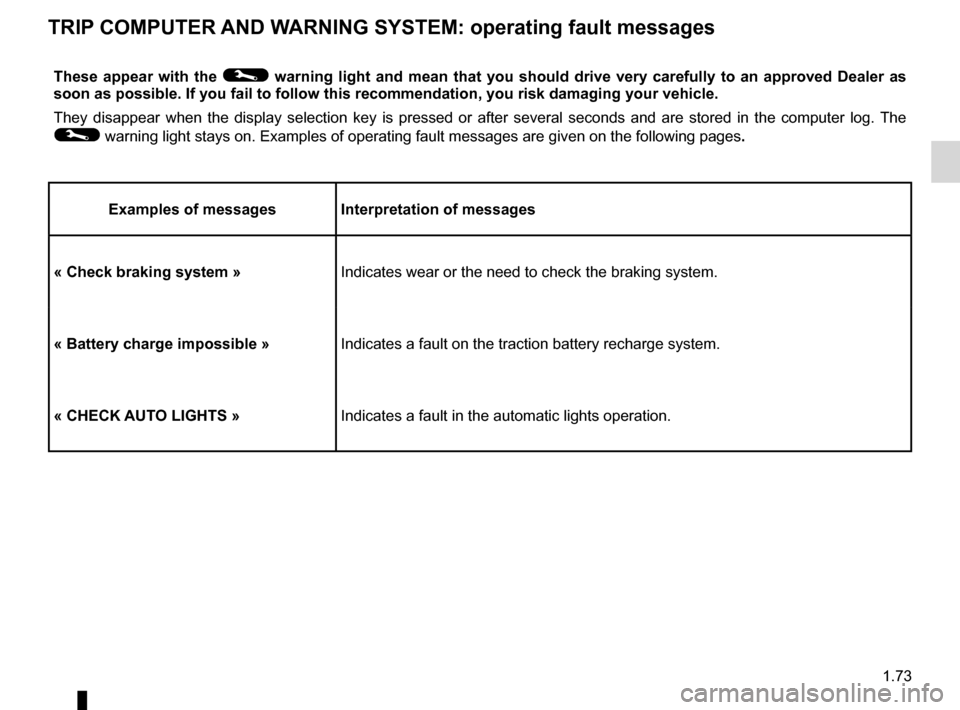
instrument panel messages...................................(current page)
trip computer and warning system .........................(current page)
instrument panel .................................................... (current page)
warning lights ......................................................... (current page)
1.73
ENG_UD25279_2
Ordinateur de bord : messages d’anomalie de fonctionnement (X61 é\
lectrique - Renault)
ENG_NU_911-4_F61e_Renault_1
these appear with the © warning light and mean that you should drive very carefully to an approved Dealer as
soon as possible. if you fail to follow this recommendation, you risk damaging your vehicle\
.
They disappear when the display selection key is pressed or after several seconds and are stored in the computer log. The
© warning light stays on. Examples of operating fault messages are given \
on the following pages .
examples of messages interpretation of messages
« check braking system »Indicates wear or the need to check the braking system.
« Battery charge impossible » Indicates a fault on the traction battery recharge system.
« checK AUt O lightS » Indicates a fault in the automatic lights operation.
triP cOmPUter AND WArNiNg SYStem: operating fault messages
Page 91 of 213
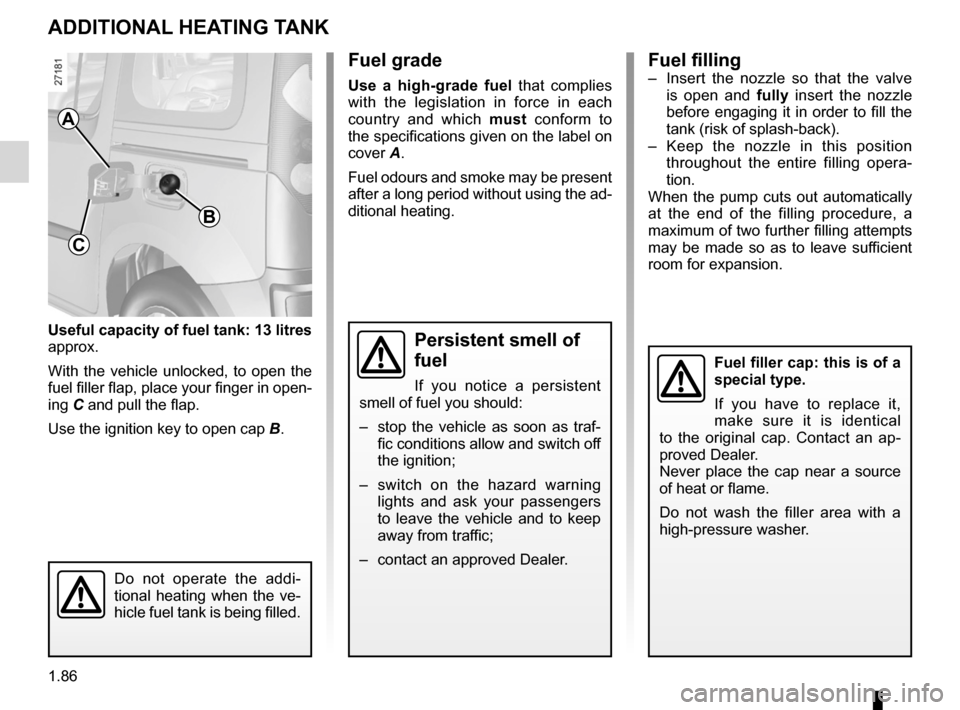
fuel filler cap ......................................... (up to the end of the DU)
fuel capacity ........................................... (up to the end of the DU)
fuel grade ............................................... (up to the end of the DU)
fuel filling ................................................ (up to the end of the DU)
additional tank capacity ........................ (up to the end of the DU)
additional heating fuel ...........................(up to the end of the DU)
additional heating additional heating fuel tank ............. (up to the end of the DU)
additional tank filling ............................. (up to the end of the DU)
additional heating tank ..........................(up to the end of the DU)
1.86
ENG_UD23011_2
Réservoir chauffage additionnel (X61 électrique - Renault)
ENG_NU_911-4_F61e_Renault_1
Additional heating tank
Useful capacity of fuel tank: 13 litres
approx.
With the vehicle unlocked, to open the
fuel filler flap, place your finger in open -
ing C and pull the flap.
Use the ignition key to open cap B.
ADDitiONAl heAtiNg tANK
Fuel grade
Use a high-grade fuel that complies
with the legislation in force in each
country and which must conform to
the specifications given on the label on
cover A.
Fuel odours and smoke may be present
after a long period without using the ad-
ditional heating.
A
c
B
Fuel filler cap: this is of a
special type.
If you have to replace it,
make sure it is identical
to the original cap. Contact an ap -
proved Dealer.
Never place the cap near a source
of heat or flame.
Do not wash the filler area with a
high-pressure washer.
Fuel filling– Insert the nozzle so that the valve
is open and fully insert the nozzle
before engaging it in order to fill the
tank (risk of splash-back).
– Keep the nozzle in this position
throughout the entire filling opera -
tion.
When the pump cuts out automatically
at the end of the filling procedure, a
maximum of two further filling attempts
may be made so as to leave sufficient
room for expansion.
Persistent smell of
fuel
If you notice a persistent
smell of fuel you should:
– stop the vehicle as soon as traf-
fic conditions allow and switch off
the ignition;
– switch on the hazard warning
lights and ask your passengers
to leave the vehicle and to keep
away from traffic;
– contact an approved Dealer.
Do not operate the addi -
tional heating when the ve-
hicle fuel tank is being filled.
Page 93 of 213
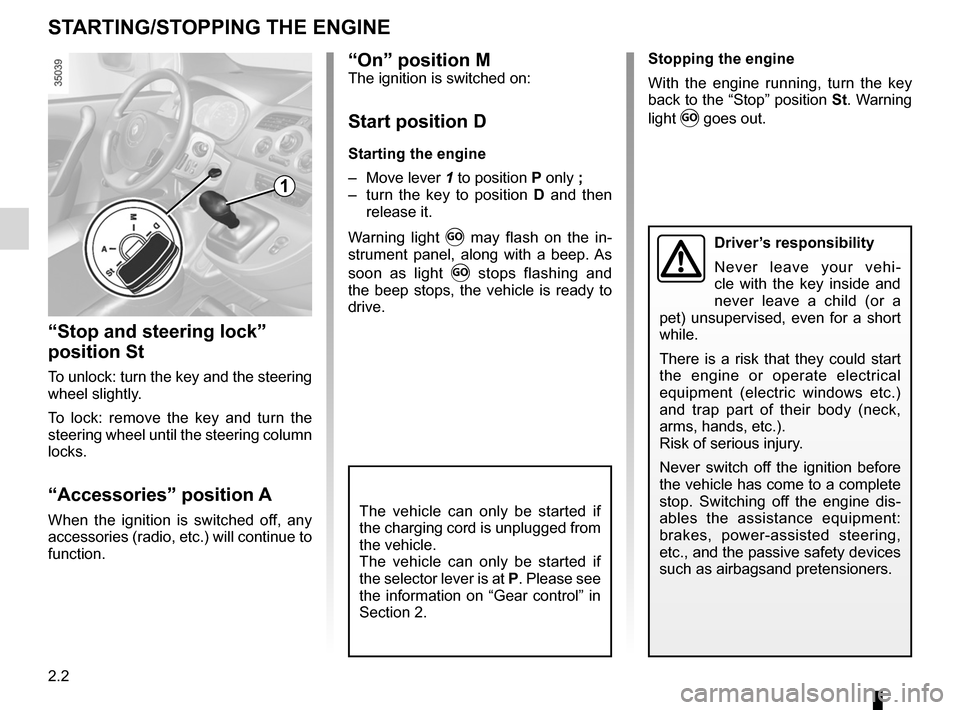
2.2
ENG_UD25284_3
Démarrage (X61 électrique - Renault)
ENG_NU_911-4_F61e_Renault_2
Starting, stopping the engine
“On” position MThe ignition is switched on:
Start position D
Starting the engine
– Move lever 1 to position P only ;
– turn the key to position D and then
release it.
Warning light
Ṑ may flash on the in -
strument panel, along with a beep. As
soon as light
Ṑ stops flashing and
the beep stops, the vehicle is ready to
drive.
Stopping the engine
With the engine running, turn the key
back to the “Stop” position St. Warning
light
Ṑ goes out.
Starting/St OPPing tHE EnginE
Driver’s responsibility
Never leave your vehi -
cle with the key inside and
never leave a child (or a
pet) unsupervised, even for a short
while.
There is a risk that they could start
the engine or operate electrical
equipment (electric windows etc.)
and trap part of their body (neck,
arms, hands, etc.).
Risk of serious injury.
Never switch off the ignition before
the vehicle has come to a complete
stop. Switching off the engine dis -
ables the assistance equipment:
brakes, power-assisted steering,
etc., and the passive safety devices
such as airbagsand pretensioners.
“Stop and steering lock”
position St
To unlock: turn the key and the steering
wheel slightly.
To lock: remove the key and turn the
steering wheel until the steering column
locks.
“accessories” position a
When the ignition is switched off, any
accessories (radio, etc.) will continue to
function.The vehicle can only be started if
the charging cord is unplugged from
the vehicle.
The vehicle can only be started if
the selector lever is at P. Please see
the information on “Gear control” in
Section 2.
1
Page 153 of 213

5.4
ENG_UD28662_1
Kit de gonflage des pneumatiques (X61 électrique - Renault)
ENG_NU_911-4_F61e_Renault_5
Jaune NoirNoir texte
Inflation kit C
In the event of a puncture, use the kit
located in the glovebox.
Open the kit, remove caps 1 and 3 (it is
essential not to remove the cap from
the bottle) then screw bottle 2 to its sup-
port 3.
tyre InFlatIOn KIt (2/5)
143
5
6
78
2Key in “accessories” position, hand-
brake engaged
– unscrew the valve cap on the wheel
concerned and screw the inflation
adapter 6 onto the valve;
– connect adapter 8 to the accessories
socket on the dashboard of the vehi-
cle;
– press switch 5 to inflate the tyre to
the recommended pressure (check
the label affixed to the edge of the
driver’s door);
– after a maximum of 5 minutes, stop
inflating and read the pressure (on
pressure gauge 4);
note: while the bottle is emptying (ap-
proximately 30 seconds), pressure
gauge 4 will briefly indicate a pressure
of 6 bar, then the pressure will drop.
– adjust the pressure: to increase
it, continue inflating with the kit, to
reduce it, turn button 7 located on
the inflation adapter.
If a minimum pressure of 1.8 bar is
not reached after 15 minutes, repair
is not possible; do not drive the ve-
hicle but contact an approved dealer.
Before using this kit, park
the vehicle at a sufficient
distance from traffic, switch
on the hazard warning
lights, apply the handbrake, ask all
passengers to leave the vehicle and
keep them away from traffic.
If the vehicle is parked on
the hard shoulder, you must
warn other road users of
your vehicle’s presence
with a warning triangle or with other
devices as per the legislation apply-
ing to the country you are in.
c
Page 179 of 213

towingbreakdown ...................................... (up to the end of the DU)
towing in the event of energy failure .......... (up to the end of the DU)
5.30
ENG_UD28666_1
Remorquage (X61 électrique - Renault)
ENG_NU_911-4_F61e_Renault_5
Jaune NoirNoir texte
Towing/breakdown
choice of breakdown service
In the event of an energy fault
In the event of a fully discharged trac-
tion battery, any type of towing is per -
mitted: towing on a flatbed truck or
towing on the road using the tow eye
(please see following pages).
all other cases
Only towing on a flatbed truck is per-
mitted.
tOwIng, BreaKDOwn (1/3)
Before repairs, insert the key in the igni -
tion to unlock the steering column. Turn
it to position m.
The regulations in force for breakdown
recovery must always be observed.t owing on a flatbed truck
Breakdown recovery must be per -
formed on a flat surface under all cir -
cumstances except where the vehicle
is immobilised following a full discharge
of the traction battery. In the event of a
total energy loss, please see the follow -
ing pages.
Page 180 of 213
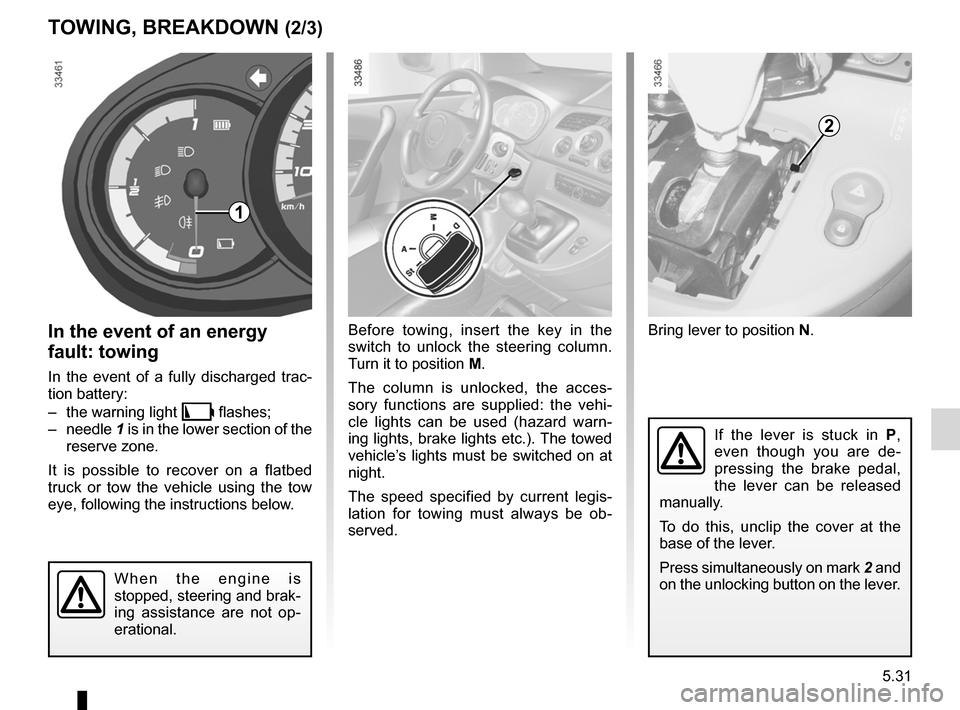
towing hitch............................................................ (current page)
JauneNoirNoir texte
5.31
ENG_UD28666_1
Remorquage (X61 électrique - Renault)
ENG_NU_911-4_F61e_Renault_5
Bring lever to position n.
tOwIng, BreaKDOwn (2/3)
In the event of an energy
fault: towing
In the event of a fully discharged trac-
tion battery:
– the warning light
Ṏ flashes;
– needle 1 is in the lower section of the
reserve zone.
It is possible to recover on a flatbed
truck or tow the vehicle using the tow
eye, following the instructions below.
W h e n t h e e n g i n e i s
stopped, steering and brak-
ing assistance are not op -
erational.
Before towing, insert the key in the
switch to unlock the steering column.
Turn it to position m.
The column is unlocked, the acces -
sory functions are supplied: the vehi -
cle lights can be used (hazard warn -
ing lights, brake lights etc.). The towed
vehicle’s lights must be switched on at
night.
The speed specified by current legis -
lation for towing must always be ob -
served.
4
1
2
If the lever is stuck in P,
even though you are de -
pressing the brake pedal,
the lever can be released
manually.
To do this, unclip the cover at the
base of the lever.
Press simultaneously on mark 2 and
on the unlocking button on the lever.
Page 181 of 213

towing hitch............................................................ (current page)
5.32
ENG_UD28666_1
Remorquage (X61 électrique - Renault)
ENG_NU_911-4_F61e_Renault_5
tOwIng, BreaKDOwn (3/3)
Do not leave the tools unse-
cured inside the vehicle as
they may come loose under
braking.
After use, check that all the tools
are correctly clipped into the tool kit,
then, depending on the vehicle, po-
sition it correctly in its housing.
Risk of injury.
Only use the front and rear towing
points (never use the driveshafts).
These towing points may only be used
for towing: never use them for lifting the
vehicle directly or indirectly.
5
3
access to towing points
Unclip cover 3 or 5.
t ighten towing hitch 4 fully: as much
as possible by hand at first, then finish
tightening it using the wheelbrace.
Towing hitch 4 and wheelbrace are lo-
cated in the tool kit in the boot (please
see Section 5 “Tool kit”).
Do not remove the key from
the ignition when the vehi -
cle is being towed.
4
4
Page 185 of 213
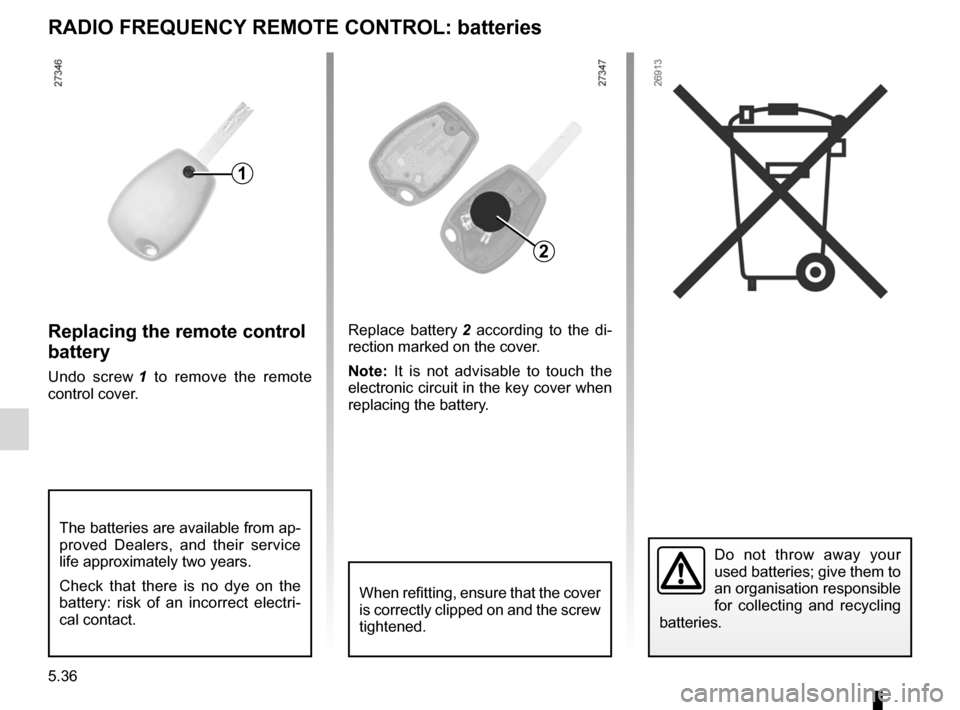
5.36
ENG_UD13290_3
Télécommande à radiofréquence : piles (X61 - F61 - K61 - Renault)
ENG_NU_911-4_F61e_Renault_5
replacing the remote control
battery
Undo screw 1 to remove the remote
control cover. Replace battery
2 according to the di -
rection marked on the cover.
n ote: It is not advisable to touch the
electronic circuit in the key cover when
replacing the battery.
Radio frequency remote control: batteries
Do not throw away your
used batteries; give them to
an organisation responsible
for collecting and recycling
batteries.
raDIO FreQuency remOte cOntrOl: batteries
1
2
When refitting, ensure that the cover
is correctly clipped on and the screw
tightened.
The batteries are available from ap-
proved Dealers, and their service
life approximately two years.
Check that there is no dye on the
battery: risk of an incorrect electri -
cal contact.